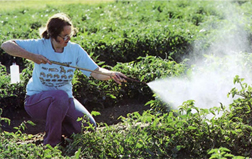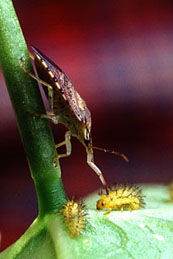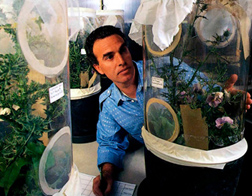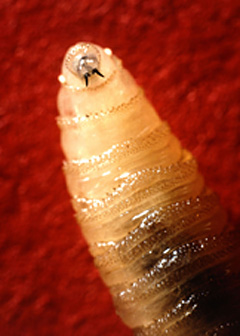|
|
During the past 100 years, scientific approaches to insect pest control have run a gamut from the naively simple to the technologically complex. But the underlying spur to these diverse research efforts has been a single immutable fact: The successful production and storage of the world's agricultural crops—and the effective protection of humans and livestock against insect-carried diseases—depend upon the sustained control of hundreds of varied and adaptable insect pests. So, even after a dynamic century of discovery and innovation, the earnest quest for safe, economical insect control methods still continues. Much has been accomplished ... and yet, so much more remains to be done ... if agriculturists are to have the means available to defend against the predations of these widespread and destructive pests.
The storm clouds of World War II had broken wide open over Europe, and the U.S. Army needed help with a big problem that came in a tiny package. It is a sad fact of life that where there are people crowded into unsanitary conditions, there are likely to be body lice ... and in the wake of those lice often comes typhus. Thus it was for the refugees of war in the Europe of the early 1940's.
Fortunately for the suffering Europeans, U.S. Department of Agriculture scientists had begun some special research in 1942 at Orlando, Florida, at the request of the U.S. Army, which was worried about the welfare of it troops a well as civilians.
Twenty-five men at Orlando bravely allowed themselves to be infested by some of the research station's colony of 75,000 lice in tests seeking an effective control against the vermin. Those volunteers did not squirm in vain. Within 4 months, Formula MYL was developed, and soon million of 2-ounce can of the powder were on their way to American and Allied troops.
|
|
The human guinea pigs at Orlando weren't the only ones contributing to the effort. Edward F. Knipling, retired director of the Entomology Division of USDA Agricultural Re earch Service, recall how chemical companies sent in hundreds of samples of their wares to be checked for possible use against not only lice, but also mosquitoes, ticks, fleas, and bedbugs. So it was that a packet of DDT arrived at the Orlando lab in early 1943 from the Geigy Co. in Switzerland.
"We put it in a test for body lice, and its lasting properties were at least twice those of the powder we'd developed," Knipling says. " It appeared to be quite safe, and in a matter of month we recommended its use by the military. Million of men, women, and children were soon dusted for lice in the war theater.
"Then we tested it for every other insect we were working on house flies, mosquitoes, bedbugs. It gave fantastic result on practically everything.
"The phenomenal result with DDT stimulated industry in the United States, Great Britain, and probably other places to look for related types of chemicals," says Knipling. "By the late 1940' s, there were several other encouraging insecticides available: benzene hexachloride, chlordane, toxaphene, aldrin, dieldrin to name a few of the chlorinated hydrocarbon."
The modern age of agricultural chemicals had begun ...to the detriment of many year of research on other alternatives.
For even before the 1940's, humans had not been entirely helpless against insects. By the time the term "biological control" was coined in 1919, scientists had already been pursing the practice for several years.
Researchers still argue about how biological control should be defined, but one simple explanation is that it is the use of parasites, predators, and pathogens to combat unwanted invaders in crops—whether those invaders are insects, weeds, or even plant diseases.
|
|
An early hero of biological control was C.Y. Riley, head of USDA's Division of Entomology upon its establishment in 1881. Prior to his USDA post—while still Missouri state entomologist Riley made the very first international shipment of an insect natural enemy when he sent specimen of a predaceous mite to France to control grape phylloxera there.
Riley was the guiding force behind one of the United States earliest and most notable successes in biological control: importation in 1888-89 of the Vedalia beetle Rodolia cardinalis, from Australia into California to battle the cottony-cushion scale, a pest threatening California's then-fledgling citrus industry.
The road to biological control looked wide and smooth in those early years. USDA exploration in Europe and Japan beginning in 1905 turned up natural enemies of the gypsy moth and brown-tail moth.
From 1905 to 1918 USDA's, Bureau of Entomology imported parasite and predator of the elm leaf beetle, alfalfa and clover leaf weevil, and sugarcane borer. In 1919, the department established a laboratory at Auch, France, to simplify the search for natural weapons; a second laboratory was established in Japan in l922.
Biocontrol scored big again when a USDA scientist, Samson R. Dutky, developed a way to produce spores of Bacillus popilliae, bacterial milky spore disease, to provide effective suppression of the Japanese beetle—the first commercial microbial pesticide.
But gradually, interest waned. Research papers published on biological control equaled in number papers on insecticide research in 1915; by 1925, papers on insecticides outnumbered those on biocontrol three to one.
The events of World War II chilled biocontrol progress even further, according to Clarence H. Hoffman, who worked with Knipling and later served as director of ARS' Entomology Division.
"There was always recognition of biological control, but I think it wasn't widely pursued as much as insecticides because when pesticides came along, they were so potent and so cheap," says Hoffman, now retired.
"When DDT came in, everything exploded. Found to be effective against over 500 pests, it was recognized as a real miracle." Says Hoffman, "DDT set off a whole series of investigations to get related compounds. The chemists had a field day." "Chemical companies began putting a lot of emphasis on developing insecticides for agriculture and other purposes," adds Knipling.
"They came up with a class of insecticides called organophosphate compounds—malathion was one, and methyl parathion, and several others—that, from the standpoint of insect control, were even more effective than the chlorinated hydrocarbons that had looked so good."
|
|
In the post-World War II years and into the era of the Korean War, ARS continued cooperating with the chemical industry in evaluating pesticides, Knipling recalls. "Most of the companies by then had their own screening programs and didn't just send us everything on their shelves," he says. "They'd only send us the promising ones to evaluate. But we did not do a whole lot of trying to develop new chemicals; industry did that." Besides, Knipling adds, there was already trouble on the horizon.
"By the early 1950's, it was becoming quite clear that, useful as these insecticides were, there were a lot of problems with their extended use," he notes.
"Wildlife biologists were becoming concerned with effects on wildlife. Chemicals were upsetting nature's balance, killing the natural biocontrol agents along with the pests. "People were finding residues in meat and milk by the early 1950's, and while we were controlling some types of insects, the overall insect problem continued to be about the same, year after year. So there were good indications that insecticides alone wouldn't be the long-range solution."
Jack R. Coulson, now an entomologist in ARS' Insect Biocontrol laboratory at Beltsville, Maryland, was still a college student in 1949-1950, when he landed an unusual summer job: feeding DDT to quail and pheasants in experiments at the U.S. Fish and Wildlife Services' Patuxent Wildlife Research Center at Laurel, Maryland.
"Even then, scientists were concerned about its getting into the food of game birds and were studying the effects of that", Coulson recalls, "Scientists were also aware of what was happening with development of pesticide resistance among insects"
And even earlier, in 1947, Clarence Hoffman had worked on a research team in Pennsylvania testing the widespread effects of aerial applications of DDT against forest insects.
"We were looking at how much you could use and be safe, using from 1 to 5 pounds per acre," Hoffman says, "I tell you, those 5 pounds per acre were really destructive. We entomologists were the first to find that birds were very vulnerable to DDT."
Among those in the scientific community who saw the handwriting on the wall was ARS's Knipling. He recalls that he began making shifts in ARS' entomology research program to do more on biocontrol, host plant resistance, changes in cultural practices and pest attractants.
"In 5 years, we'd shifted from 80 percent of our effort being on insecticides to probably not more than 50 percent," he says. "We were recommending to USDA and others that there should be more effort on biological control and other alternative methods but our appropriations were not increased."
Richard S. Soper, now the ARS national program leader for biocontrol, recalls Knipling's spreading the word in the 1960's.
"I can remember when I was a graduate student at Cornell and he came by and spoke to us." says Soper. "Dr. Knipling changed policy, going from the treadmill-like screening of insecticides and pesticides to looking at a different approach."
In 1962, Knipling's campaign got a healthy boost from the publication of the book "Silent Spring", written by Rachel Carson, that sounded a wide-spread warning about the environmental draw back of chemical use.
"'Silent Spring' got me involved in biocontrol." notes Soper. "I was writing a thesis on wood-boring beetles and the best control I found was a fungal pathogen. When "Silent Spring" came out, everyone was concerned."
"Her book probably did more than anything else to gain public attention and convince the budget people that these pesticides had caused problems and we needed to look more at biological controls" adds Knipling.
But if those who held the purse strings needed convincing, many scientists did not. "Ed Knipling was already well on his way to developing nonchemical control methods when 'Silent Spring' came out," Hoffman says.
USDA research on biological control and other alternatives to chemical insecticides boomed in the 1960's. New labs sprang up in Columbia, Missouri; Gainesville, Florida; and Fargo, North Dakota. Plant breeders concentrated more effort on developing plants with the natural ability to resist or tolerate pest attacks.
"It was almost a complete shift-80 percent of our effort was on alternatives to chemicals to control insects," says Knipling.
The successes were impressive, and led to significant savings for farmers. In 1986, it was calculated that biocontrols against the alfalfa weevil netted savings of about $48 million annually; a later report put the benefit even higher, at $88 million in 1987 dollars. And the price tag for the research was a mere $1 million—for a ratio of return on investment of about 50 to 1. Savings from biocontrol of another pest, the pea aphid, were calculated in 1984 at about $36 million annually—on alfalfa alone.
In a book he is currently editing on the first century of USDA' s biological control research, Coulson writes that since 1953, USDA's classical biocontrol program has saved growers several hundreds of millions of dollars annually, largely as a result of reduced cost of pesticide applications. This would put total grower savings from biocontrol during the past two decades at about $2 billion or more.
It's not surprising that, today, thoughts often tend to turn to biological controls as weapons against the relentless invasion of pests. But biological controls, for all their value, are no panacea, warns Coulson.
"We get a new major pest in this country about every 3 years," he says. "Biocontrol alone will have a hard tine keeping up."
In fact, one of the chief criticisms of biological control is that it moves too slowly—and does too little. Even its strongest supporters acknowledge that natural biological agents will not adequately control every insect and that they take tine to work.
"Our goal isn't 100-percent control or at least, it shouldn't be," notes Soper. "The goal is to produce a crop economically. You only have to bring the pest population levels below the economic threshold that point at which the farmer starts to lose money because of the pest."
Farmers in the future should go one step further, says Knipling, to a concept he calls "total population management." This entails widespread, coordinated attacks on populations of the major pests at the precise tine when such attacks will damage them most.
But even that won't allow a total farewell to chemicals, Knipling warns.
"We' II always need insecticides," he says. "In the United States alone, there are probably 1,000 different insects a year that cause a little bit of damage somewhere.
"But probably 100 of those insects cause damage year after year across a much wider area. It's those we should plan to control in an ecologically sound manner before they become an even bigger problem."—By Sandy Miller Hays, ARS.
Subduing the Screwworm
It's one of the greatest entomological success stories of all times and also one of the least well-known peaceful uses of atomic energy: perfection of an effective control for screwworm, Cochliomyia hominivorax (Coquerel), using x-radiation.
Obnoxious and destructive, the screwworm is the only insect known to consume the living flesh of warm-blooded animals. It has caused immeasurable suffering and losses in livestock, wildlife, and even human populations the world over.
|
|
In the 1930's, ARS scientists Edward F. Knipling and Raymond C. Bushland turned their attention to alternative screwworm control measures. They concluded that reducing or eliminating the insect population would be a better solution than treating the pest topically after entry into hosts via skin wounds, as was then commonly done. Though World War II' s pressing entomological research needs intervened, Knipling never gave up thinking about using genetic means to control screwworms.
In 1946, he was named chief of the Insects Affecting Man and Animals Division of USDA' s Bureau of Entomology and Plant Quarantine. Four years later, colleague Arthur W. Lindquist recommended to Knipling a book by Nobel laureate H.J. Muller titled "Drosophila," which discussed use of radiation to alter the genetic material of insects. Knipling immediately began a correspondence with Muller exploring the possible use of radiation to sterilize screwworms.
Convinced that the approach could work, Knipling reordered priorities to provide funding for Bushland to carry out tests at Kerrville, Texas. Bushland secured the cooperation of a nearby U.S. Army medical unit with suitable x-ray equipment. In just 6 months, it was handily demonstrated that 2,500 to 5,000 roentgens of x-rays would sterilize screwworm pupae without disrupting their adult mating behavior.
Knipling's theory was simple: Fertile females would mate with sterilized males mass-reared in insectaries and released into infested areas. With offspring resulting only from matings with native, unsterilized males, the screwworm population would gradually become insignificant and perhaps disappear.
But could it really work? First, a field test on Sanibel, the 20-square-mile Florida island, confrrmed the theory. Though encouraged, scientists knew that a larger test was needed to verify those early findings. By chance, a routine request from a veterinarian from Curacao, Netherlands Antilles, alerted them to the screwworm's presence on the 170-square-mile island. The Dutch government was eager to assist in its elimination.
So a thousand sterile flies per square mile were released each week by airplane. After just 3 weeks—the length of one screwworm reproductive cycle—about 70 per cent of new egg cases found were sterile. After the next 3 weeks of releases, sterility was 84 percent. And by the end of the third 3-week period, very few egg masses were to be found and all were sterile!
The speed with which screwworm eradication was achieved on Curacao demonstrated the great potential of this control method. Since then, strategic deployment of sterile flies has been used effectively in many locales—most recently, northern Africa—to protect vast areas from the horrific screwworm's predations.
Ever the visionary, Knipling believes that the sterile fly technique can be a successful management tool for many other insects of economic importance. "It's just a matter of working out a few more details," he says. He and Bushland were recently honored for their screwworm research by the United Nations' Food and Agriculture Organization in Rome, Italy .-By L.R. McElreath, ARS.
Shedding Light on Parasite/Host Relations
Just off press is E.F. Knipling's latest contribution to insect pest control, "Principles of Insect Parasitism Analyzed From New Perspectives." Subtitled "Practical Implications for Regulating Insect Populations by Biological Means," the 338-page book sheds light on ill-under-stood parasitoid/host interactions. Application of its principles could move the world closer to more effective, economical, and environmentally safe pest management.
The book is available for $9.50, including postage and handling, from the Superintendent of Documents, P.O. Box 371954, Pittsburgh, PA 15250-7954. Make checks payable to Superintendent of Documents and specify both stock number S/N 001-000-04582-2 and order processing code number 6237.













